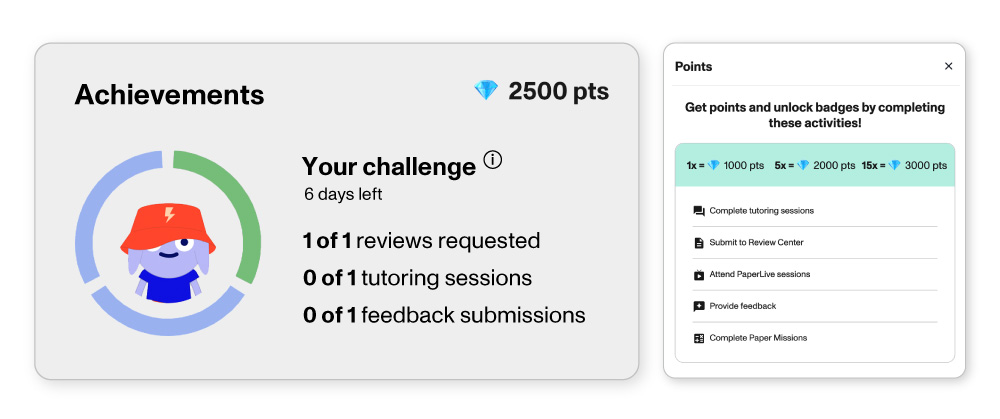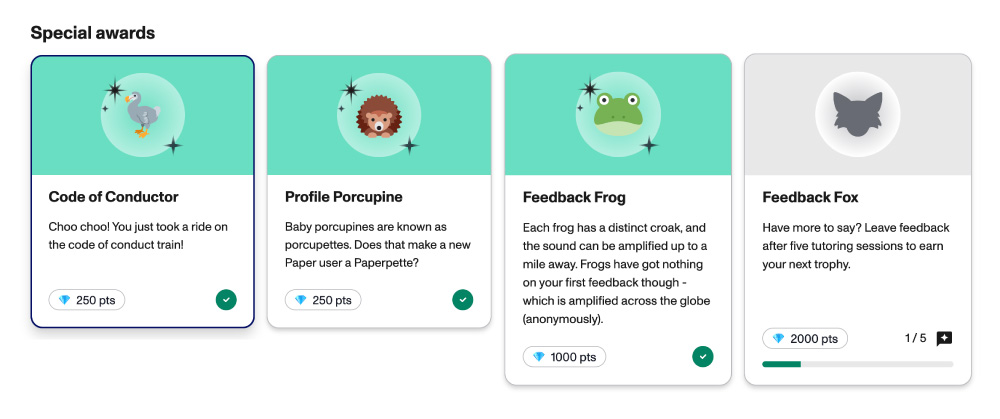
3 ways game elements can drive educational engagement [Infographic]
Games are serious business, and at Paper™, we believe they have a lot to teach us about how to motivate students, recognize their accomplishments, and offer a deeper sense of meaning and connection.
[View the full infographic: “Learning is not a game: How gaming elements strengthen education”]
Our Educational Support System (ESS) is designed to promote student engagement, and game elements are a crucial component of how we strive to get students excited about learning.
[READ: “The K-12 guide to game-based learning”]
Here are three ways game attributes can help drive student behavior while connecting learners with meaningful educational journeys.
1. Prompting students to take on activities that promote learning
How should students think of the various educational resources they have at their disposal? Should learners see them as dormant tools that sit idly by until each item has a specific role to play? Or should these resources proactively capture students’ interest, encouraging them to push forward with their academic pursuits?
We believe that our ESS can become an integral part of each student’s learning journey, so we use game elements to drive students back to the platform for more academic support and to build confidence for life.
Specifically, we use:
- Challenges: We help students gain familiarity with our ESS through a series of fun challenges. Learners are directed to try out all of the features available to them in a way that’s fun and engaging—without any pressure.
- Progress indicators: Progress indicators help students visualize the gap between what they’ve already accomplished and what they still need to do in order to close the loop on their current objectives.

Progress indicators may be particularly beneficial in situations where internal motivation is harder to find. A recent study on the impact of progress bars and badges found that both elements could be effective in motivating scientists to answer questions on a topic they likely found uninteresting.
2. Rewarding learners for completing educational activities
Posing a question or prompting students to review their progress indicators is a good start. Additionally, providing recognition for a job well done can help build trust and further reinforce positive behavior.
As we’ve mentioned, badges are one potentially effective way to celebrate various achievements. Other digital tokens may prove helpful for learners too.
On Paper’s ESS, students can earn:
- Badges, trophies, and stickers: Badges and related items give learners feedback as they develop familiarity with the various educational features available on the ESS. These rewards also give students something to look back on with a sense of accomplishment, and they can help boost participation. For example, research into the effect of badges on user activity found that participants in a peer-to-peer marketplace were more actively engaged when badges were deployed.
- Points: Who doesn’t want to earn a high score? Attaching points to an activity can encourage students to try out new challenges and continue their learning journeys. Research into the effectiveness of using game elements in higher education found that points were useful for motivating students to take on additional coursework.

3. Providing a meaningful, personalized educational experience
Storytelling is one of the main ways we make sense of the world, and educational experiences are no exception. Giving students the opportunity to construct their own identities within the digital world they inhabit—and providing intriguing narratives for them to engage with—can transform otherwise disconnected learning activities into a cohesive environment that entertains even as it instructs.
On Paper’s ESS, students engage with:
- Customizable avatars: Creating a unique virtual persona can help students shed feelings of anonymity. They’ll see themselves as being truly present online while engaging with tutors or participating in other learning activities.
- Intriguing storylines: Once you’ve helped your learners become acquainted with an educational platform’s features and attributes, how do you sustain their engagement? One way to keep students invested is to incorporate narrative elements into various learning moments. This process imbues each activity with greater significance and helps stitch individual activities together into a unified story.
![]()
Recent research on the interaction of game elements and various psychological needs indicated that avatars and meaningful stories were among the attributes that positively influenced social relatedness. As learners cultivate their own identities and participate in fun stories, they feel connected and seen.
Helping students become active participants in their own learning
Game elements serve a broad range of functions in educational environments. By motivating and rewarding positive behavior—and by helping students connect more deeply with learning platforms, academic content, and themselves—game elements can help students truly love learning.
[View the full infographic: “Learning is not a game: How gaming elements strengthen education”]
Looking for more ways to help students take ownership of their learning? Download our latest ebook, “5 ways student-centered interventions can increase engagement.”






